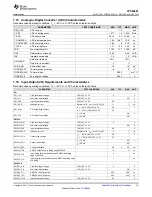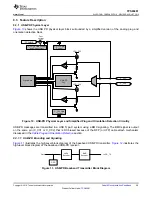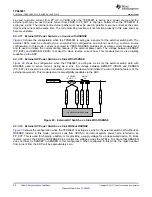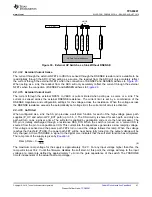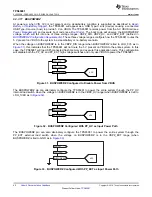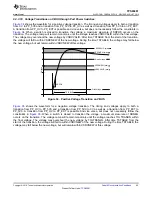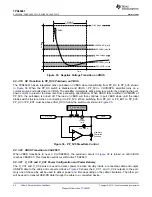
33
SLVSDC2B – FEBRUARY 2016 – REVISED AUGUST 2016
Product Folder Links:
Copyright © 2016, Texas Instruments Incorporated
Feature Description (continued)
9.3.2.1 Configured as a DFP
When configured as a DFP, the TPS65981 detects when a cable or a UFP is attached using the C_CC1 and
C_CC2 pins. When in a disconnected state, the TPS65981 monitors the voltages on these pins to determine
what, if anything, is connected. See the
for more information.
shows the high-level detection results. Refer to the
for more information.
Table 1. Cable Detect States for a DFP
C_CC1
C_CC2
CONNECTION STATE
RESULTING ACTION
Open
Open
Nothing attached
Continue monitoring both C_CC pins for attach. Power is not applied to VBUS or
VCONN until a UFP connect is detected.
Rd
Open
UFP attached
Monitor C_CC1 for detach. Power is applied to VBUS but not to VCONN (C_CC2).
Open
Rd
UFP attached
Monitor C_CC2 for detach. Power is applied to VBUS but not to VCONN (C_CC1).
Ra
Open
Powered Cable/No UFP
attached
Monitor C_CC2 for a UFP attach and C_CC1 for cable detach. Power is not applied
to VBUS or VCONN (C_CC1) until a UFP attach is detected.
Open
Ra
Powered Cable/No UFP
attached
Monitor C_CC1 for a UFP attach and C_CC2 for cable detach. Power is not applied
to VBUS or VCONN (C_CC1) until a UFP attach is detected.
Ra
Rd
Powered Cable/UFP Attached
Provide power on VBUS and VCONN (C_CC1) then monitor C_CC2 for a UFP
detach. C_CC1 is not monitored for a detach.
Rd
Ra
Powered Cable/UFP attached
Provide power on VBUS and VCONN (C_CC2) then monitor C_CC1 for a UFP
detach. C_CC2 is not monitored for a detach.
Rd
Rd
Debug Accessory Mode
attached
Sense either C_CC pin for detach.
Ra
Ra
Audio Adapter Accessory
Mode attached
Sense either C_CC pin for detach.
When the TPS65981 is configured as a DFP, a current IH_CC is driven out each C_CCn pin and each pin is
monitored for different states. When a UFP is attached to the pin, a pull-down resistance of Rd to GND will exist.
The current IH_CC is then forced across the resistance Rd generating a voltage at the C_CCn pin.
When configured as a DFP advertising Default USB current sourcing capability, the TPS65981 applies
IH_CC_USB to each C_CCn pin. When a UFP with a pull-down resistance R
D
is attached, the voltage on the
C_CCn pin will pull below VH_CCD_USB. The TPS65981 can also be configured as a DFP to advertise default
(500 mA), 1.5-A and 3-A sourcing capabilities.
When the C_CCn pin is connected to an active cable VCONN (power to the active cable), the pull-down
resistance
will
be
different
(Ra).
In
this
case,
the
voltage
on
the
C_CCn
pin
will
pull
below
VH_CCA_USB/1P5/3P0 and the system will recognize the active cable.
The VH_CCD_USB/1P5/3P0 thresholds are monitored to detect a disconnection from each of these cases
respectively. When a connection has been recognized and the voltage on the C_CCn pin rises above the
VH_CCD_USB/1P5/3P0 threshold, the system will register a disconnection.
9.3.2.2 Configured as a UFP
When the TPS65981 is configured as a UFP, the TPS65981 presents a pull-down resistance R
D_CC
on each
C_CCn pin and waits for a DFP to attach and pull-up the voltage on the pin. The DFP will pull-up the C_CC pin
by applying either a resistance or a current. The UFP detects an attachment by the presence of VBUS. The UFP
determines the advertised current from the DFP by the pull-up applied to the C_CCn pin.
9.3.2.3 Dead-Battery or No-Battery Support
Type-C USB ports require a sink to present Rd on the CC pin before a USB Type-C source will provide a voltage
on VBUS. The TPS65981 is hardware-configurable to present this Rd during a dead-battery or no-battery
condition. Additional circuitry provides a mechanism to turn off this Rd when the port is acting as a source.
shows the RPD_Gn pin used to configure the behavior of the C_CCn pins, and elaborates on the basic
cable plug and orientation detection block shown in
. RPD_G1 and RPD_G2 configure C_CC1 and
C_CC2 respectively. A resistance R_RPD is connected to the gate of the pull-down FET on each C_CCn pin.

